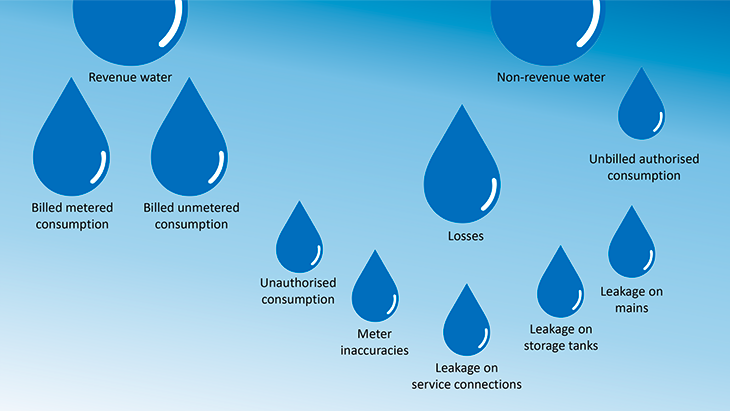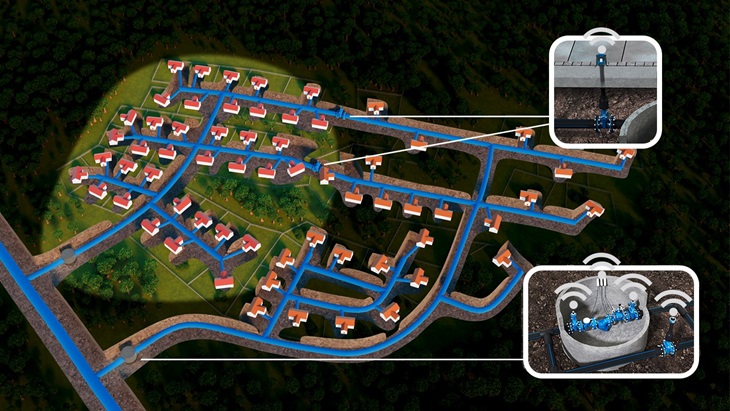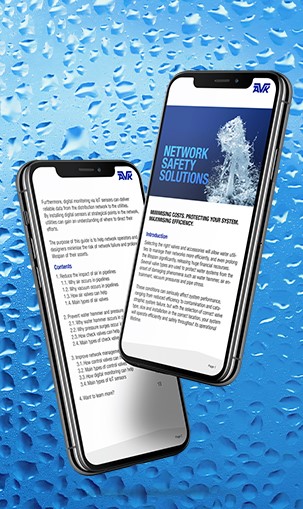
Managing non-revenue water (NRW)
Across the globe, significant amounts of vital water resources are lost every second due to high levels of non-revenue water (NRW). This persistent challenge affects not only the financial stability of water utilities but also places immense strain on the environment. Each drop lost requires additional water to be produced and distributed, escalating energy consumption, operational costs, and the depletion of already scarce water reserves. Tackling NRW is a critical step toward creating sustainable, efficient water management systems that safeguard both economic and environmental health.
Access to clean water is often taken for granted, much like the air we breathe. Yet, water is a finite resource, and water scarcity is a significant challenge in many parts of the world. This issue is driven by factors such as climate changes, increasing population density, and inefficient water management systems. A critical but often overlooked aspect of this challenge is water loss, or non-revenue water (NRW).
What is non-revenue water?
Non-revenue water (NRW) is produced, cleaned water that is lost somewhere in the water distribution system and never reaches the consumers. When water is lost, the production costs and energy invested in treating and distributing it are wasted. This inefficiency not only drains financial resources but also amplifies the environmental impact. To compensate for the lost water, additional water must be produced and distributed, further straining water sources and increasing energy consumption.

Non-revenue water is a global challenge
The problem is universal, ranging from NRW levels of about 5 % to as much as 80 % in certain areas.
Global water loss has been estimated to 126 billion cubic metres per year, equivalent to the cost of $39 billion each year. Could these water losses be reduced by only one-third, the savings would be enough to supply 800 million people (Liemberger & Wyatt, 2018).
European thresholds on leakage rates
Sustainable water supply is on the international political agenda, among other things with the European Drinking Water Directive. The purpose of the directive is to ensure safe and clean drinking water for all Europeans. It concerns materials in contact with the drinking water and limit values to be accepted in water distribution, and it focuses on risk management and lowering water loss.
To increase investment in maintenance and renewal of the drinking water infrastructure and thereby reduce water loss, the European Commission will by 2028 have adopted a threshold on allowed leakage rates. Member states who exceed this will have to present an action plan within two years from then. It is therefore not only of local interest to reduce NRW levels but may soon also be a legal requirement.
What causes non-revenue water?
There are many causes of water loss, ranging from leakages, pipe bursts, and poor water management to illegal connections and unauthorised consumption.
Leakages and pipe bursts
Leakages cause water loss from the pipe network and occur, among other things, at pipe bursts. This means that cleaned water is lost and never reaches the consumers. Water lost through leakages is a waste of resources and has an impact on both the performance of the utilities and the consumers through potential inconvenience. Leakages and pipe bursts can occur suddenly or develop gradually over time due to lack of maintenance, corrosion or wear and tear.


Inadequate water management
In many parts of the world, inadequate management of water resources contributes to water loss. This can include a lack of maintenance of the supply network, leading to leakages and pipe bursts, or lack of customer meters, so that the utilities cannot bill the consumers based on actual consumption.
Unauthorised consumption
Theft of water or filling of a vacuum tanker from a random fire hydrant not assigned for the purpose are examples of unauthorised consumption that increases the amount of non-revenue water.
Dividing the network into district metering areas
It is not an easy task to operate a water distribution network. A network often covers an extensive area and a complex, hidden system of pipes, making it difficult to detect changes, damages or illegal connections.
Dividing the supply network into smaller sections – district metering areas (DMA) – is a more efficient way of managing NRW. DMAs provide the ability to measure water balance and to secure low pressure for each section separately. Operators are then able to better plan and prioritise their efforts, and this way, dividing your network into DMAs can optimise the efficiency of the entire network and lead to significant savings in operating and maintenance costs, as well as reduced water loss.

AVK solutions for optimising DMAs and reducing non-revenue water
Regulating valves and pressure management
Regulating valves allow for pressure control in the supply network. Low pressure reduces water loss through existing leakages and reduces the risk of pipe bursts. We offer a wide range of regulating valves in several variants and configurations:
Dynamic pressure management provides a constant pressure for a critical area such as a tall building, an area with old pipes or the area in the supply network with the most pressure fluctuations. This allows you to maintain a low average pressure, reducing water loss through existing leakages. You can also minimise pressure fluctuations, which will extend the life span of your network by reducing pipe stress and the risk of water loss due to pipe bursts. AVK solutions for pressure management:
- Hydraulic pilot operated pressure reducing control valves with AUMA Profox
- Hydraulic pilot operated pressure reducing control valves with dual stage pressure set point
Learn more about the advantages of pressure management in the supply network, and how it helps reducing water loss and NRW levels.


Battery-operated IoT sensors
Wireless, battery-operated IoT sensors can collect data directly from the distribution network and help detect water loss. With AVK Smart Water sensors you can save resources, optimise planning and operation activities and thereby reduce water loss:
- VIDI Positioner for monitoring valve open/close position in percentages
- VIDI Cap for monitoring fire hydrants
- VIDI Pressure for monitoring pressure at DMA inlet and at critical points in the supply network
- VIDI Flow for monitoring the amount of water entering a DMA, which enables reliable water balance calculations
- VIDI Open/Close for indication of valve position: opened, closed or in between
- VIDI Temperature for monitoring water temperature in the supply network
- VIDI Level for measuring distance to the nearest surface for monitoring sand traps and wells
Network security and pipe repair
Water loss due to pipe cracks and bursts can be minimized through effective leak repair. We offer various repair collars and clamps to secure fast, safe and efficient repair, and even for permanent repair under pressure:


Choosing the right valves allows water utilities to manage the distribution network efficiently. Preventing water hammer and air in the system will extend the lifespan of the network by reducing pipe stress, and thereby protecting against pipeline bursts and water loss. We offer a wide range of check valves and air valves for network safety:
- Swing check valves, nozzle check valves, silent check valves
- Automatic air valves, air & vacuum valves, combination air valves
Surface boxes for use with noise loggers
Leakages can easily be detected through noise loggers integrated in ground-level surface boxes, enabling operators to set in exactly when and where needed. This secures quick repair, meaning less water lost and a minimum disturbance of the network customers.
AVK offers a wide range of synthetic surface boxes, some of which allow storage of the necessary equipment for noise loggers, like microphone, software installation, battery and antenna. The surface boxes are available as a lockable version making it tamperproof.
See our wide range of synthetic surface boxes.




